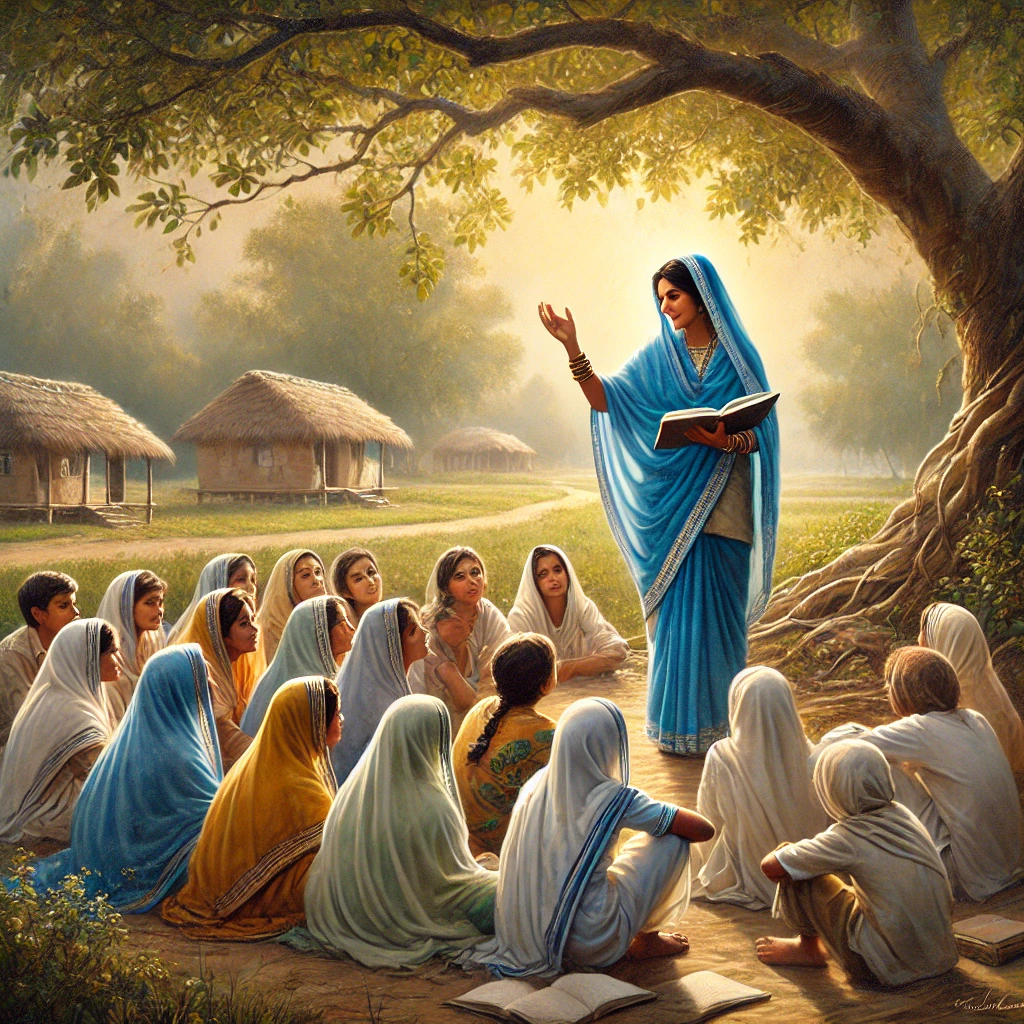What is National Girl Child Day?
January 24th is celebrated as the National Girl Child Day in India every year since 2008. This day holds an objective to raise awareness of the importance of women among the mass. This day is also celebrated to educate people on the importance of girl children, a vital part of India’s Young population.
Strong women have fought against prevalent social injustices and customs throughout Indian history. They have given their entire lives to effect a tremendous shift. Born before their time, they are the social reformers. Happy National Girl Child Day! Let's learn more about these courageous Indian women.
Also Read: Save Girl Child Speech,
Women Visionaries of India
History signifies how women were oppressed by the prevailing patriarchal society. To this date, there are many places where families still consider women as a burden and even think of discarding girl children.
Due to the brilliant ventures of women social reformers in different aspects of society, we have been able to establish the importance of women and have been able to raise awareness regarding their birthrights.
Here is a list of women reformers who made society bow down to their indomitable spirit.
1. Savitribai Phule
Savitribai Phule was India’s first female teacher who changed the way people thought about women’s education. At a time when women weren’t even allowed to leave their homes, Savitribai dreamed of learning and teaching.
Her husband supported her dream, gave her a basic education, and encouraged her to attend school, breaking societal norms. Later, Savitribai opened schools for girls, despite facing a lot of criticism. People would throw dirt and cow dung at her on her way to school in Pune, so she carried an extra saree to change into before teaching.
Although she was married at the young age of 9, she didn’t let that hold her back. By 1851, she had started three schools in Pune with 150 students—most of them girls, which was rare at the time. Over her life, Savitribai established 18 schools, fought for gender equality, and formed the Mahila Seva Mandal to support women’s education and rights. Despite the opposition she faced, she became a symbol of hope and change for women in India.

2. Fatima Sheikh
Fatima Sheikh was a guiding light for women, offering hope for a better future through education. Her efforts in promoting education made her one of the most important social reformers, even though her name is often forgotten in history.
Coming from a conservative Muslim society, Fatima and her brother, Usman Sheikh, showed incredible courage. When Savitribai Phule and Jyotirao Phule were driven out of their home, they opened their doors to them. Fatima was well-educated and trained to teach students.
Together with Savitribai, she became one of the first female teachers, bringing significant change. Fatima and her brother ignored society's criticism and even turned their home into a school. Despite facing opposition from both Hindu and Muslim religious leaders, she remained focused on her mission. She went door to door, urging families to educate their daughters.
Fatima Sheikh’s efforts make her a true inspiration and a figure to remember during National Girl Child Day celebrations.

3. Chandraprabha Saikiani
She was a freedom fighter, activist, social reformer, and writer, known as a pioneer of feminist movements in Assam. In the early 20th century, she fought against patriarchy and brought attention to women's injustices during colonial rule.
Despite challenges, she and her sister crossed waist-deep muddy areas to attend a boys' school. Impressed by her determination, school inspector Nilkanta Barua awarded her a scholarship, but she was denied a hostel stay because she was a girl. She also stood firm against religious bias, refusing to convert to Christianity and advocating for fairness for all religions.
At just 13, she began educating other girls and became Assam’s first female doctor. Her life was fully dedicated to social reform, making her an inspiring figure for National Girl Child Day.

Also Read: Save Girl Child Essay in English
Why National Girl Child Day is Celebrated on 24th January?
We can celebrate this day by looking at the National Girl Child Day history. On 24th January 2008, we celebrated the first National Girl Child Day. It is done to raise awareness among the population of India regarding the importance of girl children for our country’s future. Since then, this day has been celebrated in our country.
The prime objective of celebrating this day is to change the attitude of society toward women. A girl child faces a lot of discrimination even in her family and outside. Female foeticide has reduced to a considerable extent due to such awareness programs.
The prime aim is to encourage people to nurture girls, the other pillar of human civilization. Without them, we will not survive. We need more Savitribai, Fatima, and Chandraprabha to bring such marvellous social reforms to shape a better future for all.
National Girl Child Day 2025 Theme
The Indian government has not officially announced a theme for National Girl Child Day 2025. Previously, slogans included “Educate a girl, build a nation, Digital Generation, Our Generation” The day serves to emphasize the importance of girls' rights, education, and their role in building a progressive society.
Objectives of National Girl Child Day 2025
Educating people about the rights of girl children and emphasising the importance of gender equality in society.
Highlighting the need for quality education and opportunities for girls to help them achieve their dreams.
Addressing all the problems that are faced by girls in areas like healthcare, nutrition, and opportunities by eliminating biases or inequalities.
Encouraging girls to become confident, self-reliant, and active participants in decision-making.
Providing them with initiatives and policies that support the welfare and development of girl children in India.
Motivating communities to work together to create a safe, supportive, and nurturing environment for every girl child.
National Girl Child Day Wishes:
"To every girl, may your dreams be as limitless as the sky. Happy National Girl Child Day!"
"Girls are the architects of change. Celebrating their strength, brilliance, and boundless potential today!"
"May every girl be a beacon of courage, wisdom, and grace. Wishing all girls a Happy National Girl Child Day!"
"Girls are stars that light up our world. Shine bright, dream big! Happy National Girl Child Day!"
"Here's to the girls who dare to dream, inspire, and conquer. Happy National Girl Child Day!"
Top 5 National Girl Child Day Quotes
Every girl deserves a world where her dreams are bigger than the challenges she faces.
Educate a girl, and you light up a whole generation.
A girl's strength is the foundation of a brighter tomorrow—let’s support her every step.
When you empower a girl, you empower an entire community.
Celebrate her, educate her, and watch her change the world.
National Girl Child Day Slogans 2025
"Girl Power! She can change the world, one dream at a time"
"Educate a girl, build a nation"
"GIRL means Gift In Real Life"
"She dreams big, let her fly high"
Conclusion
National Girl Child Day is a celebration of the visionary women shaping India's future. It emphasises the importance of empowering girls, offering them equal opportunities, and breaking societal stereotypes. By recognising and nurturing their talents, we pave the way for a brighter, more inclusive society. Let's continue to support and uplift the girl child, ensuring they thrive and contribute meaningfully to every facet of life. National Girl Child Day serves as a reminder of the boundless potential within every girl, inspiring collective efforts to create a world where gender equality is not just a vision but a lived reality. The prime aim is to encourage people to nurture girls, the other pillar of human civilization. Without them, we will not survive. We need more Savitribai, Fatima, and Chandraprabha to bring such marvelous social reforms to shape a better future for all.
FAQs on National Girl Child Day 2025: History, Significance, and it’s importance
1. Why National Girl Child Day is celebrated on 24 January?
National Girl Child Day is celebrated on January 24th to honour the vision of empowering and nurturing the girl child. This day serves as a reminder of the crucial role girls play in society and advocates for their rights, education, and well-being.
2. Why is National Girl Child Day celebrated in India?
National Girl Child Day is celebrated to raise awareness about the importance of empowering girls, promoting gender equality, and highlighting their contributions to society.
3. When is National Girl Child Day observed each year?
National Girl Child Day is observed on January 24th annually, emphasizing the need to address challenges faced by girls and to celebrate their achievements.
4. What is the significance of National Girl Child Day?
The day holds significance in promoting the rights, education, and well-being of girls. It aims to eradicate gender-based discrimination and create a society where girls thrive.
5. How can one participate in National Girl Child Day celebrations?
Participation can involve spreading awareness, supporting girl-centric initiatives, and engaging in discussions on gender equality. Schools, communities, and organizations often organize events.
6. What is the theme for National Girl Child Day 2025?
As of now, the Indian government has not officially announced a theme for 2025. Themes in the past have focused on empowering the digital generation with slogans like “Digital Generation, Our Generation, Our Time is Now—Our Rights, Our Future.”
7. How can schools and families celebrate National Girl Child Day?
Schools can organise awareness campaigns, debates, or art competitions on gender equality. Families can celebrate by supporting the education and aspirations of their daughters and ensuring equal opportunities for them in all areas of life.
8. How does Vedantu support the vision of National Girl Child Day?
Vedantu supports the cause by making quality education accessible for all children, including girls, through its online platform. By offering free mock tests, interactive classes, and affordable learning resources, Vedantu ensures that every girl has the tools to succeed academically and achieve her dreams.
9. What are the key challenges faced by girls in India that National Girl Child Day addresses?
National Girl Child Day focuses on challenges like gender inequality, limited access to education, child marriage, and poor healthcare. It aims to create awareness and take action to overcome these barriers, ensuring a brighter future for every girl.
10. How can individuals contribute to the goals of National Girl Child Day?
Individuals can contribute by supporting the education of girls, advocating for equal opportunities, mentoring young girls, and raising awareness about their rights. Small steps, like breaking stereotypes and encouraging their ambitions, can create a big impact.







